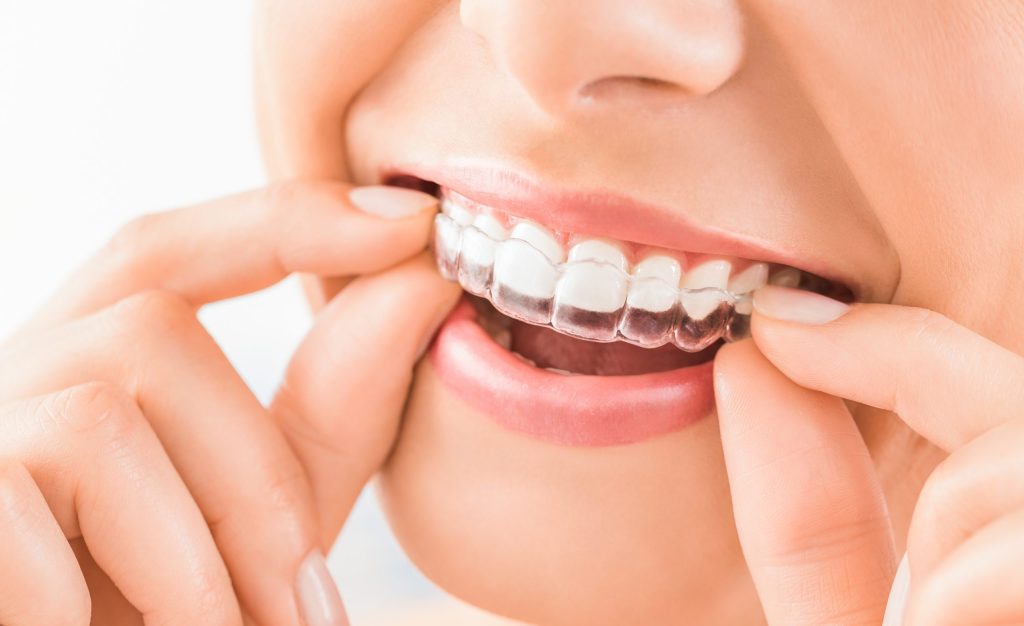Making the Best Choice for Your Smile in Waterford, MI
If you’re considering orthodontic treatment, you’ve likely come across two popular options: Invisalign and traditional braces. Both can straighten your teeth and improve your smile, but they work in different ways and suit different needs. Dr. Amanda Sheehan, a trusted dentist in Waterford, MI, at Oakland Family Dental, is here to guide you through the decision-making process.
If you’re in Waterford, Clarkston, Pontiac, or the nearby areas, call Oakland Family Dental at (248) 674-0384 to determine which treatment is best for you.
What Are Invisalign and Braces?
Invisalign
Invisalign clear aligners use a series of clear, removable aligners to gradually shift crooked teeth into the correct position. These aligners are custom-made for comfort and are virtually invisible, making them a discreet choice.
Braces
Traditional braces use metal brackets and wires attached to your teeth to realign them. They’ve been around for decades and are highly effective at treating even the most complex misaligned teeth.
Key Differences Between Invisalign and Braces
When choosing between Invisalign and braces, understanding their differences can help you make the best decision. Here’s how they compare:
- Appearance: Invisalign aligners are clear and nearly invisible, making them a discreet choice, while traditional braces use metal brackets and wires that are more noticeable. For a less visible alternative, braces are also available in ceramic or clear materials.
- Comfort: Invisalign aligners are smooth and custom-made, so they fit comfortably over your teeth without irritating your gums or cheeks. Braces, on the other hand, may cause some discomfort from brackets and wires, particularly after adjustments.
- Lifestyle Impact: Invisalign aligners are removable, allowing you to eat your favorite foods and maintain your regular brushing and flossing routine. Braces are fixed, which means avoiding sticky, hard, or chewy foods and taking extra care when cleaning around the brackets and wires.
- Treatment Time: Invisalign is often quicker for mild to moderate cases, typically lasting 6–18 months. Braces, which can handle even the most complex orthodontic issues, usually take 18–24 months or more.
- Maintenance: With Invisalign, you’ll need to clean your aligners daily and stick to wearing them for 20–22 hours a day. Braces require diligent oral hygiene to clean around the brackets and wires and regular dental visits for adjustments.
Each option offers unique benefits, and the best choice depends on your specific orthodontic needs and personal preferences.
Which Option Is Best for You?
Invisalign is ideal for:
- Adults and teens seeking a nearly invisible solution.
- Patients with mild to moderate misalignments.
- Those who can commit to wearing aligners 20 to22 hours daily.
Braces are better for:
- Children or those with severe orthodontic issues.
- Patients who may not consistently wear aligners.
Dr. Sheehan can assess your smile and recommend the most effective treatment for your unique needs.
Cost Comparison
The cost of Invisalign and braces depends on the complexity of your case. Invisalign may have a slightly higher price tag due to its advanced technology, but flexible financing options are often available. Oakland Family Dental offers affordable payment plans to help you achieve your dream smile without breaking the bank.
Frequently Asked Questions
Yes, Invisalign is generally less painful than traditional metal braces. The reason for this is that Invisalign uses a series of smooth plastic aligners that are custom-made to fit your teeth, reducing the likelihood of irritation and soreness. Although there may still be some discomfort when switching to a new set of aligners every few weeks, it is often milder compared to the pain and soreness experienced with adjustments for braces.
In many cases, it’s possible to switch from traditional braces to Invisalign trays, but it’s not a decision that should be taken lightly. Before making the switch, your orthodontist will need to assess your specific dental needs and the progress of your current treatment. If your orthodontic issues are compatible with Invisalign, and you haven’t made significant progress with braces, switching might be an option.
Invisalign typically causes less discomfort than traditional braces. Traditional braces, with their metal brackets and wires, can cause sores inside the mouth and be uncomfortable when tightened. On the other hand, Invisalign aligners are made from smooth plastic, reducing the likelihood of mouth irritation. However, both options can cause some discomfort, especially when teeth are initially moving or when new aligners are introduced in the case of Invisalign.
